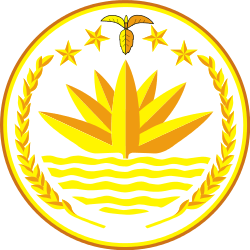National Emblem of Bangladesh
| National Emblem of Bangladesh বাংলাদেশের জাতীয় প্রতীক | |
|---|---|
 | |
| Details | |
| Armiger | People's Republic of Bangladesh |
| Adopted | 1971 |
| Escutcheon | The national flower Shapla resting on water, having on each side and ear of paddy and being surmounted by three connected leaves of jute with two stars on each side of the leaves |
The national emblem of Bangladesh (Bengali: বাংলাদেশের জাতীয় প্রতীক - Bānglādēśēr Jātīẏo Pratīk) was adopted shortly after independence in 1971.
Located on the emblem is a water lily, that is bordered on two sides by rice sheaves. Above the water lilly are four stars and three connected jute leaves. The water lily is the country's national flower,(seven pedals represent the seven birsresthas(War Heroes)) and is representative of the many rivers that run through Bangladesh.Five lines represent the main five rivers of Bangladesh : padma, meghna, jamuna, bharmaputra and karnapuli. Rice represents its presence as the staple food of Bangladesh, and for the agriculture of that nation. The four stars represent the four founding principles that were originally enshrined in the first constitution of Bangladesh in 1972: territory, population, sovereignty and government.
The details of the emblem is given as quoted below:
The national emblem of the Republic is the national flower Shapla (Nymphaea nouchali) resting on water, having on each side and ear of paddy and being surmounted by three connected leaves of jute with two stars on each side of the leaves. - Constitution of Bangladesh Article 4(3)[1][2]
 Presidential Seal of Bangladesh
Presidential Seal of Bangladesh Seal of the Prime Minister of Bangladesh
Seal of the Prime Minister of Bangladesh Seal of the Chief Adviser of Caretaker Government
Seal of the Chief Adviser of Caretaker Government
See also
References
- ↑ A Hossain; G Kabir; M M Ud-deen & A M S Alam (2007). "Cytological studies of Nymphaea species available in Bangladesh". Journal of Bio-Science. 15: 7–13.
- ↑ "Archived copy" (PDF). Archived from the original (PDF) on 2013-09-22. Retrieved 2013-06-20.
